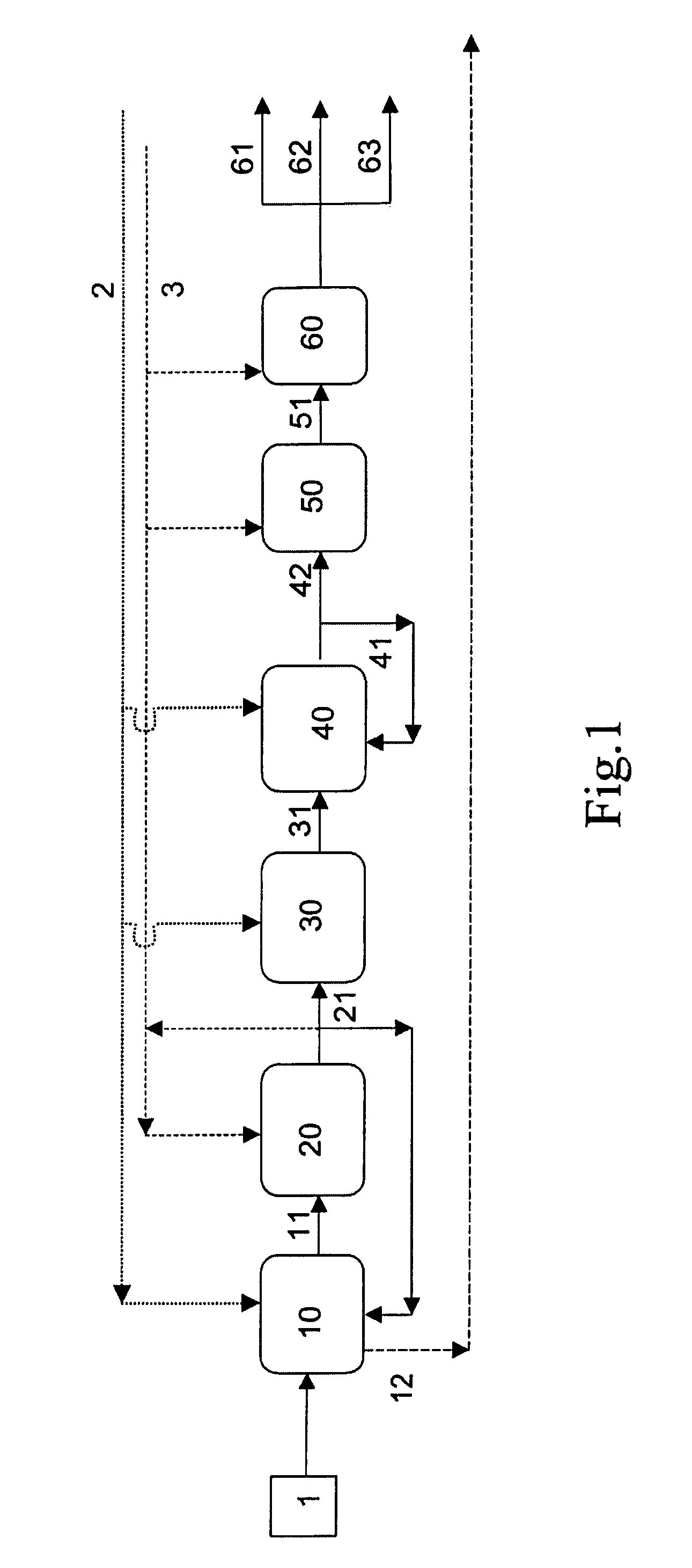Process for the manufacture of base oil
a technology for base oil and hydrocarbons, which is applied in the direction of hydrocarbon preparation catalysts, hydrocarbons from oxygen organic compounds, hydrocarbons, etc., can solve the problems of less suitable for new engines, less environmental protection, and limited use, so as to reduce emissions, reduce global warming impacts, and reduce environmental benefits.
- Summary
- Abstract
- Description
- Claims
- Application Information
AI Technical Summary
Benefits of technology
Problems solved by technology
Method used
Image
Examples
example 1
Manufacture of Alpha-Olefins from Fatty Acids
[0100]Alpha-olefins were produced from distilled C16 fatty acid feed. The alpha-olefins were prepared by feeding 200 g fatty acids together with 1.5 molar excess of C16 fatty alcohol to an autoclave under stirring to form a wax ester through esterification reaction. Esterification took place under atmospheric pressure at a temperature of 250° C. Reaction time was 3 hours. No catalyst was used. Water liberated in the reaction was purged with nitrogen flow of 6 l / h.
[0101]The obtained wax ester and hydrogen were thereafter charged to the fixed bed hydrogenation reactor, where they were brought in contact with a copper-chromite catalyst at 230° C. and 30 MPa pressure, forming C16 fatty alcohols. The product was cooled and the liquid crude fatty alcohol was separated. A part of this prepared fatty alcohol was used in esterification.
[0102]The fatty alcohol obtained above was dehydrated in a flow reactor with zirconia / gamma-alumina catalyst, whe...
example 2
Oligomerization of Alpha-Olefins in a Batch Reactor
[0104]50 g of 1-hexadecene and 2 g of a catalyst were mixed in an autoclave reactor. The catalysts used are shown in Table 3 below. The mixture was heated to 200° C. for 24 hours under nitrogen atmosphere. The pressure was 2.0 MPa. Conversion of the reaction was calculated to all products other than C16.
[0105]
TABLE 31-hexadecene oligomerizationCatalystBeta 1Beta 2YH-MCM-41C16 conversion (%)Product distribution (wt-%):62777774111113branched C16=3320923n-C16=53143C17-C31171836C3228396142C48581120>C481213
[0106]The catalysts used were Y-zeolite (TOSOH Co.), beta-zeolite 1 (TOSOH Co.) and beta-zeolite 2 (TOSOH Co.), and the mesoporous material MCM-41 was prepared according to Catalysis Letters 36 (1996) 103.
[0107]As can be seen in Table 3 a high yield of C32 dimer and C48 trimer is obtained. The C16 monomer residue is mostly branched olefin and after hydrogenation it may suitably be used as a diesel fuel.
example 3
Oligomerization in a Fixed Bed Reactor
[0108]1-hexadecene was fed to a fixed bed tubular reactor with 5 g catalyst diluted with silicon carbide in ratio 1:3. The catalyst used was mesoporous material MCM-41, described in example 2, the aluminium content of which was 2.5 wt-%, amount of acidic sites 150 μmol / g and surface area of mesopores >800 m2. The reactor temperature was 200° C., the pressure was 2.0 MPa and the feed rate was 10 g / h. The reaction was followed by GC analysis. In Table 4 the conversion and the composition of oligomerization product is presented at different times on stream.
[0109]
TABLE 41-hexadecene oligomerization in fixed bed reactorTOS (h) (time on stream)Product624304854727896distribution (wt-C16 conversion (%)%):787168646154524732211111Branched C16=2024242423242321n-C16=2581216222532C17-C3152111111C324351515049454440C482115141110765>C4861010000
PUM
| Property | Measurement | Unit |
|---|---|---|
| total carbon number | aaaaa | aaaaa |
| temperature | aaaaa | aaaaa |
| pressure | aaaaa | aaaaa |
Abstract
Description
Claims
Application Information
 Login to View More
Login to View More - R&D
- Intellectual Property
- Life Sciences
- Materials
- Tech Scout
- Unparalleled Data Quality
- Higher Quality Content
- 60% Fewer Hallucinations
Browse by: Latest US Patents, China's latest patents, Technical Efficacy Thesaurus, Application Domain, Technology Topic, Popular Technical Reports.
© 2025 PatSnap. All rights reserved.Legal|Privacy policy|Modern Slavery Act Transparency Statement|Sitemap|About US| Contact US: help@patsnap.com


